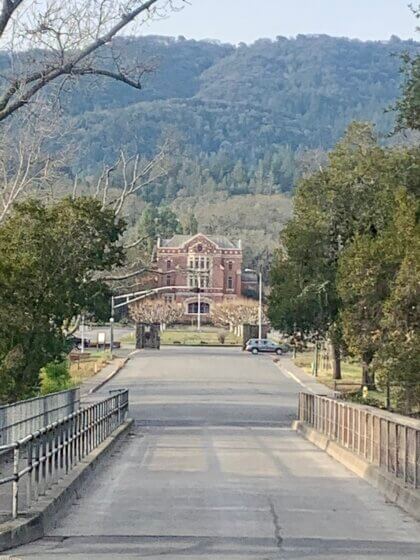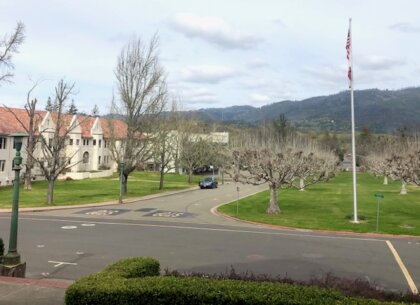SDC – A proposal for community control

By David Bolling | Reporting for The Sun —
The Sonoma Developmental Center – 945 acres rolling off the slope of Sonoma mountain and down across the floor of Sonoma Valley – is a unique piece of public land, the value of which can’t be measured in dollars, and the fate of which may be decided, very soon, based on its dollar value.
As wildlife habitat it is a keystone corridor for animal migrations from Sonoma Mountain to the west and the Mayacamas range to the east. Species traveling through, or inhabiting, that corridor range from the very bottom to the very top of the food chain. For that reason alone, SDC (its shorthand name) is of unparalleled importance. We’re talking about California red legged frogs and mountain lions, steelhead trout and Chinook salmon, old growth redwoods and heritage oaks.
But its value goes well beyond the plant and animal life that call it home. It has hosted human life well into the mists of recorded history, even though the unwritten heritage of the Miwok, Patwin, Pomo, and Wappo people is hard to find. As a sequestered, scenic, bucolic, and blessed space, humans have found solitude, tranquility, and escape from everyday life on the forested trails, the open fields, the singing streams, and the ascending slopes that climb nearly 2,300 feet to the top of Sonoma Mountain. It is the natural environment that inspired two remarkable women to move the California Association for the Care and Training of Feeble Minded Children to a 1,640-acre parcel there in 1891. The facility would experience three name changes, and a population increase from 148 residents to some 3,200, by the 1950s, served by up to 1,300 staff.
As an asylum for the most vulnerable, least understood, and frequently victimized members of society, SDC provided protection, care, security, and love, even while its residents were sometimes abused, demeaned, even subjected to involuntary sterilization and other medical “experiments.”
Doing great good while simultaneously inflicting grave harm is a pattern recorded throughout human history, and SDC offers an invaluable historical record of both the evolving insights and the persistent ignorance reflected in service to the care of people with developmental disabilities.
And despite its gruesome, almost inhuman record as a national leader in forced sterilization, SDC was pioneering in virtually all aspects of care provided to its special population, with extraordinary departments for developing adaptive technologies to transport, clothe, feed, house, educate, and promote independence and self-advocacy. A fulltime cobbler department generated a steady flow of custom-made shoes for residents whose physical deformities required unique designs. Dentists skilled in serving non-verbal patients provided hard-to-find oral care. And a high percentage of caring staff were trained as psychiatric technicians (“psych techs”) whose average income was more than $58,000 and could be double that. Typical income for most caregivers in the small group homes to which SDC residents were moved is minimum wage, and the care too often is minimum wage care.
Central to the therapeutic experience at SDC was access to the outdoors, to a farm with barnyard animals, to the beauty of the sprawling campus. And adequate space was an important asset to buffer the sometimes loud and aggressive behavior of so-called “behavioral” residents who often act out their frustrations over their constrained lives.
In a 2015 letter to the Department of Developmental Services, Sonoma resident and active volunteer Kathy Aanestad, reflected on the uniquely therapeutic values offered at SDC. “SDC is a sacred place and an ideal place for people and nature to mend, heal, and thrive,” she wrote. “Society needs to honor this sacredness by keeping and/or adding social programs, not taking them away.”
Added Aanestad, “The sanctity of this area would be enhanced by the inclusion of units for housing environmental and wildlife groups, people working hard, caring for Mother Earth and all her creatures. When we protect our sacred places, care for those less fortunate than ourselves, society is elevated.”
That sentiment echoes the feelings of a large number of Sonoma Valley residents who have voiced opposition to the SDC Specific Plan, developed by PRMD (the Sonoma County Planning Department) to guide the future development of the site. As you read this, the Sonoma County Board of Supervisors may have already voted to adopt the recommendation of the county’s Planning Commission, which voted four-to-one in November to approve a plan with 1,000 residential units, projected to house 2,400 people in a mix of market rate and affordable housing, along with a luxury hotel, live-work artist studios, an institute and/or retreat center, research and development spaces, some retail stores, possibly a small institutional campus, a community gym, and a revitalized farming operation referred to as the “Agrihood.”
 A 789-page Environmental Impact Report concluded that, despite widespread concerns about traffic gridlock during future wildfires, and virtually no discussion about the seismic safety of the two reservoirs on site, there is not a single environmental issue on the entire property that would require mitigation.
A 789-page Environmental Impact Report concluded that, despite widespread concerns about traffic gridlock during future wildfires, and virtually no discussion about the seismic safety of the two reservoirs on site, there is not a single environmental issue on the entire property that would require mitigation.
Tamara Galantar, a consulting attorney to the Sonoma Land Trust who specializes in analysis of Environmental Impact Reports, said of the Specific Plan EIR that it appears to assume that the Plan will be “self-regulating.”
And Planning Commissioner Greg Carr, representing Sonoma Valley, observed, “I suspect the EIR will be litigated,” an off-the-record assumption other stakeholders in the plan process have said they agree with.
Meanwhile, the 1,000-unit cap placed on housing could be exceeded if, as Commissioner Eric Koenigshofer suggested, state law governing ADUs (Accessory Dwelling Units, sometimes called “granny units”) could allow one ADU for each individual residential parcel. In response to which a PRD staffer noted, “One of the things we probably have the least control over is ADUs.”
Underlying the entire Specific Plan process is the fundamental assumption that the California Department of General Services (DGS), which administers control over the state’s surplus lands, will sell the SDC property to whichever developer is chosen to build out the plan. That assumption is what drives PRD to conclude there will have to be 1,000 dwelling units because anything less will not provide enough profit margin to entice a developer to invest. And it is an assumption that, some Plan critics believe, will ultimately doom the property in the long term because profit motive will drive all decision making and plan execution.
Enter Norman Gilroy, and a trio of cohorts from the Glen Ellen Historical Society, with a 38-page proposal already submitted to DGS with four dramatically different “community principles” and titled, “The Next Hundred Years At SDC.
The four “widely held” principles are:
- Keep the land at SDC in public ownership in perpetuity.
- Make sure the local community has a strong say in the future of the land.
- Protect the open space, and expand the wildlife and riparian corridors.
- Choose a rural scale of development compatible with the Sonoma Valley.
In addition, the total number of living units would be capped at 470, with most of them to be affordable units for workforce, elders, and rental housing.
The mechanism for doing all this is the creation of a legal entity called the Sonoma Mountain Community Services District, within which a non-profit Sonoma Mountain Community Trust would be created, independently managed by a panel of commissioners, and guided by a brain trust of experts and advisors.
The District would require enabling legislation by the State Legislature, which would also approve transfer of SDC to the District. Preliminary District boundaries would encompass some 3,500 voters in Glen Ellen and Sonoma Valley. According to Gilroy, as a public agency, the District could claim priority standing with DGS for the disposition of state surplus property.
The financial model that emerges from this proposal is radically different from the County’s plan. Gilroy says funding could be initiated with bonds secured by property taxes on the value of new buildings, much like the tax-increment financing formerly used to fund community development projects.
The Hundred Years proposal would utilize adaptive re-use for many of the existing buildings the county plan would demolish. An emerging reuse strategy widely used in Europe, called “second skin” technology, incorporates panels of pre-wired, pre-plumbed siding that cover existing walls, significantly reducing demolition costs and reducing carbon footprints.
Concerns that a small, local, on-the-ground initiative could succeed in realizing this proposal might be allayed given the qualifications of the principals behind it.
Norman Gilroy has global large project experience, including the downtown master plan for Pago Pago in Western Samoa, the housing project at Larkspur Landing in Marin, along with the ferry terminal, historic reclamation in San Francisco’s Western Addition, coastal management projects from California to Italy, and regional planning projects in Alaska and Sweden.
Dr. Bean Anderson is a software engineer with 35 years of project leadership experience. And Teresa Murphy spent 30 years working at SDC, with 20 years as part of the executive team, and knows virtually every aspect of the entire facility.
The big question, of course, is how decision makers at DGS will respond to the proposal, now one of three known to have been submitted for state review. Gilroy and Anderson met with DGS staff and, says Gilroy, they were very well received.
“It looks like the door is still open for discussion,” he says, “They were very respectful, thoughtful, we felt they were being very serious about the proposal. They offered us an hour and a half and they kept us for two and a quarter hours.”
As encouraging as that may be, and as much as the Next Hundred Years plan appeals to Sonoma Valley residents, it remains to be seen whether the Glen Ellen Historical Society proposal will be able fund the annual costs of basic upkeep on the sheltered property when state funding runs out July 1, 2023. At that point, the cost of law enforcement, fire protection, water, electricity – all the services to maintain a warm shutdown – will come due. The State has not released the annual cost of those services, but informed estimates put the figure at somewhere between $5 million and $10 million per year. If no funding source has been identified, the state has vowed to begin selling the property to the highest bidder or bidders.
Meanwhile, a quiet if off-the-record consensus has been building among involved stakeholders that the County’s EIR is so deficient that it is all but guaranteed to be challenged in court. If that happens, it’s unlikely that any developer would touch SDC until the EIR issues are resolved.
First District Supervisor Susan Gorin, who has consistently opposed the County’s 1,000 unit proposal says, “Oh, absolutely there will be litigation,” and expects that a final solution to the uncertain future of SDC may well be years away.






